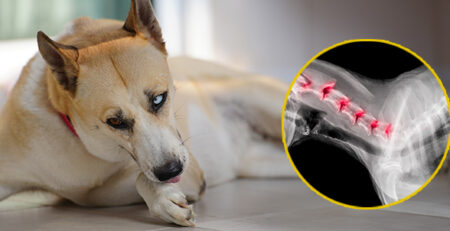What is degenerative dog myelopathy (DM) and how to improve the quality of life of the four-legged sufferer
Canine degenerative myelopathy is a neurological disease that affects the spinal cord of dogs causing a progressive
motor deficit in the hind legs
.
It was first described in 1973 in the German Shepherd.
Although it has been observed with particular frequency in this breed, degenerative myelopathy also affects other breeds of dogs, especially large dogs.
Specifically, the disease is common in Pembroke Welsh corgis, Boxers, Rhodesian ridgebacks, and Chesapeake Bay Retrievers.
Symptoms of canine degenerative myelopathy
It usually occurs between 5 and 10 years of age and has a progressive and chronic course.
The most obvious symptom is an initial lack of posterior train coordination (ataxia) that worsens to the point of limb dragging and unfortunately results in the inability to ambulate (paralysis).
In the final stages of the disease, fecal and urinary incontinence may appear.
The hypotheses about the triggers
Underlying the disease resides a degeneration of white matter in the spinal cord.
Through the white matter of the spinal cord occurs the transmission of sensory impulses from the limbs to the brain and consequently the transmission from the brain to the limbs of motor impulses.
In individuals with degenerative myelopathy, white matter lesions are evident throughout the spinal cord but have a higher incidence in the thoracolumbar tract.
These lesions are similar to those observed in spinal cord sections of human ALS (amyotrophic lateral sclerosis) patients with mutations in the SOD1 (Superoxide Dismutase 1 ) gene.
So, the clinical similarities between DM and ALS reasonably suggest that inherited genetic predisposition is the main cause of the onset of the disease.
Other credited hypotheses are nutritional deficiencies and immune-mediated degenerative mechanisms.
DNA testing and early diagnosis
Since it is a hereditary disease, canine degenerative myelopathy can be detected early in young subjects by DNA testing to detect the presence of the SOD1 gene in its mutated form.
In the absence of this finding, the diagnosis is issued on the basis of the neurological examination and after exclusion of other orthopedic or degenerative diseases affecting the spine.
The instrumental examination of choice is MRI.
How to treat a dog with degenerative myelopathy
Prognosis is closely related to the severity of the neurological deficits found and the degree and nature of spinal cord compression.
Unfortunately, it is not possible to stop the course of the disease however but one can support the dog with therapeutic treatment in the early stages of the disease so as to delay its development.
Physical therapy and rehabilitation also help slow the degenerative process.
These practices limit the onset of atrophy (muscle loss) and preserve forelimb function, stimulating the dog’s coordination and balance.
In this way, the quality of life of the animal can be improved.
If you suspect your dog has degenerative myelopathy or is an at-risk breed, contact the veterinary specialists on our staff for a checkup.
We would also like to remind you that in case of need and urgency Clinica La Veterinaria is always open h24 every day including holidays and with First Aid service from 8 pm to 8 am.











